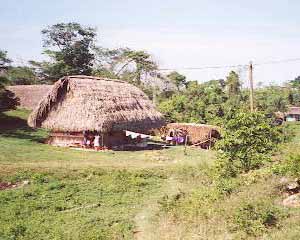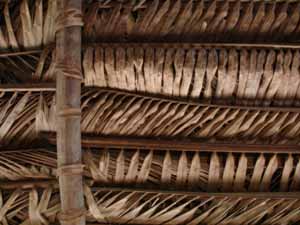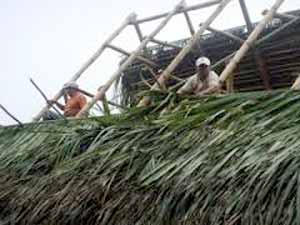Building with thatch
To Thatch or not to thatch. It is a question of sustainability. Thatch is undoubtedly beautiful and creates an authentic ambience that guests really love. It was our own enjoyment of sleeping under thatch that led us to want to include it in the design for our own lodge. It looks good and it keeps the room much cooler than other roofing materials. It is local, so transport costs are low making the carbon footprint of the roof low. It provides income for local people who, having gained permission from their village and the Forest Department, will cut the leaf and carry it to the road side for collection in bundles. So it looks like a win win for sustainable building; great aesthetic and provides income for local people. What could be simpler? The thatch in question is bay leaf palm rather than the more commonplace but less attractive and less durable cohune palm. Cohune grows everywhere on disturbed forest land. The leaves are cut, split along their central stem and then placed in bundles of three to five along the roof. The bay leaf palm is a sub canopy species that grows in the shade of other trees so can only be found in well forested areas. It is circular fan leaf that is then squeezed into a broom shape and woven into the roofing framework. It grows on forest land that is managed by the neighbouring villages. Bay leaf makes a beautiful roof as can be seen in innumerable lodges throughout Belize but it is becoming increasingly difficult to find and therefore more expensive and transport costs rise as people look further afield. So why is this a problem? It is a renewable resource. It is a plant after all and can be fairly easily regrown although it is a slow grower and may take up to ten years before it can spare leaves for roofing. Why is it not being replanted? The answer appears to lie in the system of communal landholding. One of our recent suppliers told us that he was not planning to plant more palms closer to the village because if he did a neighbour might harvest it. This raises all sorts of interesting questions about landholding. Surely the village council can devise a simple system to ensure that the person who plants can also reap. And surely a villager who knows that the palms were planted by a neighbour would respect that and leave them alone. Apparently not. So despite the fact that most villagers recognize that bay leaf palm is a diminishing resource that will lead to a vanishing income in a few years time no-one seems to be devising and implementing simple systems to ensure its sustainability. So it seems that land holding is rather similar to property holding. The owner of a house is more likely to maintain and improve it than the tenant of a similar house. And by the same token the owner of forest land is more likely to maintain and ensure its sustainability. Right now thousands of feet of valuable rosewood is being extracted illegally from the forests of Toledo with the aided and abetted by local residents but while land issues remain uncertain it is likely to continue. In the meantime we have changed the roofs on our two new rooms from bay leaf palm thatch to zinc over a ceiling made from very attractive secondary woods such as Nargusta, Billy Webb, Cabbage Bark, Santa Maria and Milady. I hope that someone is replanting these too. by The Lodge at Big Falls |




